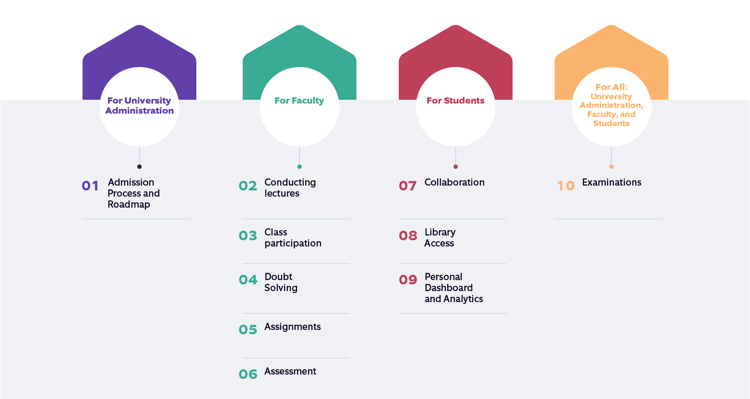From offices to campuses, the COVID-19 pandemic has taken everything—from banking to education—online. Although we are missing interacting and socializing in person, this virtual connection has helped maintain a sense of community.
As we move towards Education 4.0 amidst a global pandemic, blended learning is clearly the way forward. Though the concept has been around for some time now, COVID-19 has just been a catalyst for all universities to adapt to it and thrive. In simple words, blended learning is a combination of online vs. offline learning and demands hardware capability combined with the power of a Learning Management System (LMS). It offers incredible solutions, which go beyond the call and make it truly an experience for the students while solving major future issues.
It’s time to move beyond the classroom with blended learning!
Let’s look at a ten-point blended learning strategy that incorporates cutting-edge technology solutions used around the world.
For University Administration
1. Admission Process and Roadmap
In the new normal, the university will need to understand the applicants and help them with a roadmap to choose and customize their learning journey by using data-driven decisions. The strategy will help in planning the blended learning journey.
AI and ML can come to the rescue as universities can use their platforms to not only make the entire admission process online, but also help the students customize their journey. Dr. Zachary Pardos Assistant Professor at Berkley, is developing the same model for the students by using Machine Learning. The model will help students carve their path and will also make suggestions to practice specific skills using artificial intelligence.
For Faculty
2. Conducting lectures
The term blended implies a hybrid model and the first problem to solve is how a faculty should conduct lectures going ahead. The core issue is that the students can be in class or at their home (if they choose to avail the off-campus studying option).
In such cases, the university can follow a 3-step approach:
- Flipped classroom – This refers to a division of the course in a ratio of classes vs. self-learning wherein students attend a certain number of credit hours in a live class and a certain number of hours going through pre-recorded videos (available on their LMS). Essentially, it means theory at home and practical in the class.
- Access from anywhere – Students have the facility to tune in to a live class from anywhere and the option of being either in a physical classroom or online from their room. All the live classes will have a subtitle facility for the online students.
- Recording access and easy navigation – All the classes can be recorded and uploaded on LMS where students can access and navigate through the important parts smoothly with video indexing. Students can also use the share-clip/comment option to tag the instructor and seek clarifications for any doubts.
As per students interviewed from the Buffalo State University, the institution provides students with an option to make their timetable as the same class is offered on different time schedules. This gives flexibility to the students across the globe to either be in class (physically present) or online (based on their time zones).
3. Class participation
Having offline and online students simultaneously can create the problem of class participation and marks thereof. It is difficult for the teaching assistants to keep a tab on the same and for the faculty to keep the class engaged with a productive contribution. Enter, Mood Tracker!
Mood Tracker - A pose detection feature that uses deep learning algorithms to process live-video streams, which can be used to check how students are responding to the sessions. The feedback will help the faculty design better classes, which drive fruitful engagement and conversations. The platform can block opening new browser tabs, flag any unwarranted activity, and send push notifications to students by asking quick questions to keep them active, alert, and engaged.
Along with a background screen showing all the online students together and a mic so that everyone can listen to all the points, an AI model can be trained to listen to the conversation. So every time a faculty praises a student saying - excellent point, the marks are allocated to the respective students and the scores are then updated on their LMS with a comment to help each student understand what worked and what did not. Besides, it will also help teaching assistants in keeping track of every teaching activity.
4. Doubt Solving
While taking the class, it can become cumbersome for the faculty to address and resolve all the doubts there and then. Traditionally, universities have engaged teaching assistants and allocated office-hours for the same, which incurs heavy costs.
In addition to the share-clip/comment mentioned earlier, there are two more features that can help reduce the burden:
- Discussion forum - A discussion forum on LMS where anyone can start a thread to ask or discuss any questions with either the faculty, teaching assistants, or fellow students.
- Virtual Bots - Many universities are now leveraging AI and ML to come up with teaching assistant BOTS for classes wherein most of the FAQs can be asked during the live classes and answered by a chatbot.
In 2015, Prof Ashok Goel, a Computer Science Professor at Georgia Tech, was teaching an online course on Artificial Intelligence. At the end of the course, students were surprised to know that one of their favorite teaching assistants answering most of their questions, Jill Watson, was a bot! The team members had collated all the chats generated over a year to feed an AI program and were able to respond to FAQs with 97% accuracy.
5. Assignments
When instructors want to invest their time on lesson planning and research, giving assignments can be a time-consuming task.
The LMS can have a built-in feature to create polls, quizzes, and subjective assignments. It can also allow smooth integration of simulations for students to learn in groups and get individual performance feedback. With customized learning becoming the new normal, the system can use each student’s data points through their class participation to create customized assignments as per their progress in the course.
6. Assessment
After the assignments have been submitted, the next major exercise is to assess and grade them.
The assessment process can be made quicker and easier by integrating tools for plagiarism check, grammar check, and digital assessment on certain parameters that can be pre-fed in the program.
Companies like Embibe, Knewton, Interview Bit have been using AI and ML-based digital assessment solutions for their students.
For Students
7. Collaboration
This is the most diversified group in the university education system. Ranging from technical fields such as STEM to extremely synthetic ones like arts, music and philosophy, the needs are wide-ranging. Collaboration among students in group projects is a critical aspect of university learning. This situation becomes even more tricky when some students are not present physically. There is a need to improve the way students interact currently. Here are a few interventions to boost student interaction:
- An LMS-based student forum where students can start topic-wise questions and anyone can answer the questions, including the faculty. The students get incentivized for answering questions, and get points and badges such as “Friend in need”, “Enthusiastic”, “Smart”, “Creative”, etc. and this helps solve both course and non-course related questions.
- Study groups can be made on LMS with WhatsApp integration and AI can be used to grade the communication between them.
As per a student interviewed from University College London, the varsity has been using the online study group model as it has students accessing the course from all over the world. Each group has a designated teaching assistant to rate the conversation and mark them on the same.
8. Library Access
In the current COVID scenario, since social distancing is a norm, libraries are now off-limits for students. Therefore, providing virtual libraries is the way forward. A one-stop platform to access e-copy of books, journals, and research papers would help students overcome the need to purchase physical books, which they would use only for a term or two. Having said that, it must also be ensured that the copyright and IPR issues are ironed out with the publishers.
9. Personal Dashboard and Analytics
The ability to track their progress not only motivates students but also helps them stay focused. We can create a dashboard for students to view their attendance, grades, progress with various course materials and a general comparison with the cohort.
At the same time, our system can recommend courses and certifications depending on the student’s intended career trajectory, existing skill sets, academic and non-academic performances. Further, students can be suggested the best career paths basis the 360 view of the students’ performance.
Besides, the faculty gets reports about at-risk students, the effectiveness of course materials, overall learning outcomes of the students, and student feedback.
For All - University Administration, Faculty, and Students
10. Examinations
The biggest challenge confronting universities during the pandemic is in conducting unbiased online exams while ensuring fairness. While writing the exam, it is important for the stakeholders to ensure the student is a registered one, not cheating, not moving in between, and is not accessing any other digital resources.
Artificial intelligence provides an effective solution to this issue, with solutions looking to evaluate the online exam environment through retinal tracking, environment stimulus tracking, and IP tracking. Combined with the power of machine learning, the data generated through such digital examinations will auto-generate evaluation papers and a course of action for each student to help teachers focus on the facilitation part. Companies like Mercer Mettl and Littlemore Innovation are providing digital exam solutions by using AI and ML.
 10 point strategy to implement blended learning
10 point strategy to implement blended learning
This 10-step strategy can help your university get a wholesome blended learning experience with resilient futuristic solutions. If you’ve also been thinking to kick-start blended learning, connect with our experts today!






